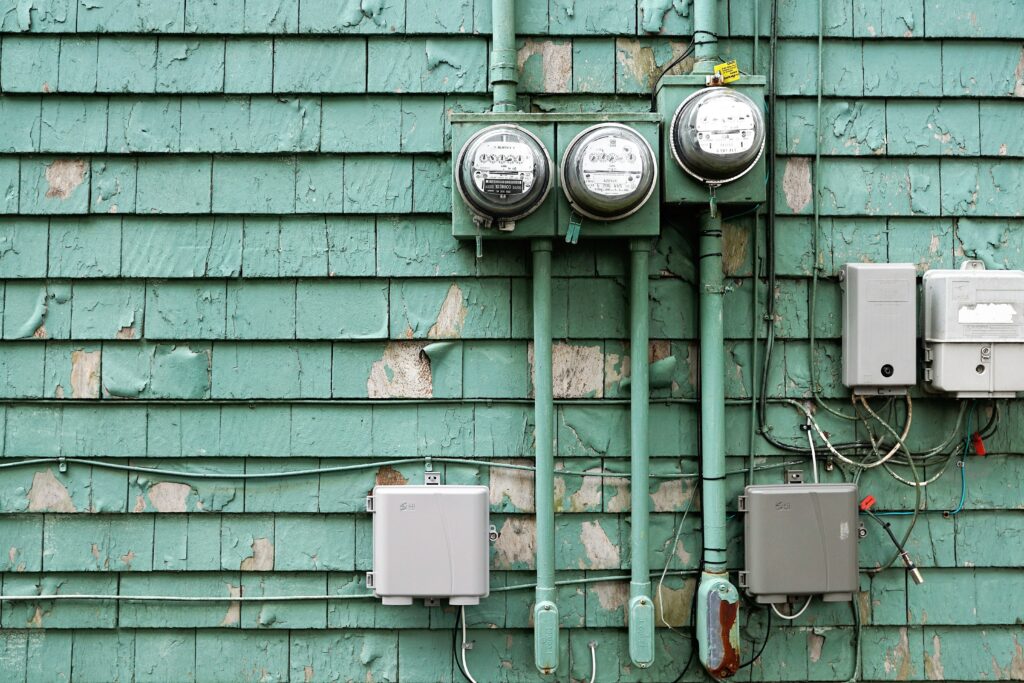
When you think of electrification upgrades for your home, you’re probably thinking about heat pumps, solar panels, maybe an EV charger. But you can get a big efficiency boost with upgrades to your traditional electrical systems, like the circuit breaker panel or even just the wiring in your walls.
Electrical panels’ life expectancy is 20-30 years, but adding to your home’s cumulative electrical load may move up that timeline. New panels can solve hiccups in your system, reduce strain, and waste less energy. Your wiring may also have hidden issues that hold back efficiency – or make your home unsafe – and require an update.
Here’s a rundown of potential key upgrades, what they entail, and why you might consider them.
Panel Upgrades
A higher-amperage electrical panel can ensure you meet increasing power demands safely and efficiently. If you’re increasing your home’s electrical requirements and need more power, it’s a good idea to look into the age and amperage of your current panel.
What Your Electrical Panel Actually Does
A panel manages the amount of electricity distributed throughout your home. It organizes and distributes electricity into various circuits, each with their own circuit breaker. A main circuit breaker regulates power to the whole house, and individual breakers regulate power to specific areas.
How to Tell If It's Time for an Upgrade
If your panel is more than a couple decades old, or if your home’s electrical needs have gone up an upgrade may be in order. Additionally, if you notice buzzing from your panel, or things like circuit breaker trips, non-functional outlets, and flickering lights, that may indicate your panel is no longer adequate.
What a Panel Upgrade Involves
Panel upgrades involve new fuses, panel wiring, and breakers. Panel upgrade options include amperage levels – you can get a 100-amp upgrade, 200-amp upgrade, or higher. Especially if you plan on electrifying any other home systems or getting new appliances, get an electrician to assess your home’s requirements to determine the best panel size.
Getting a new panel is an up-front cost of a few hundred to a few thousand dollars, but the efficiency savings and safety improvements might make it well worth the effort.
Outlets and Wiring
Up-to-date, well-installed outlets and wiring can keep your appliances functioning better and more efficiently as well. Since faulty wiring is a major cause of fires, improving in this area is likely the biggest step you can take to safeguard your home.
The Hidden Impact of Old Wiring
Older homes often have less-safe wiring construction and materials, such as aluminum wires from the 1960s and 1970s, or knob-and-tube systems from the pre-1950s. Knob-and-tube systems – where a copper wire is run through ceramic knobs and tubes – are extremely common in older homes, but they pose big safety risks. What’s more, their limited capacity means they can’t handle modern electrical requirements.
Some homes even have the old two-pronged outlets, which were standard until the 1960s – three-prong outlets are grounded, meaning they have a third wire that protects you from shock. However, even newer houses may have faulty wiring or loose outlets and could use updates.
Warning Signs Your Wiring Might Be Unsafe
Again, flickering lights or circuit breaker trips are a tell – your wiring may not be smoothly distributing enough power throughout your home. You may need outlet changes if device plugs fall out easily or some outlets don’t function. Sparks, a burnt odor, or discoloration in the walls are also obviously a huge red flag, safety-wise.
Most wiring problems are a simple matter of age or obvious electrical problems, and need to be replaced for safety reasons. But you can also see benefits after upgrades: New materials are designed to handle higher loads with less resistance, and they can make it easier to do further renovations and improvements to your home in the future. It can also help extend the lifespan of your devices and appliances – many electrical-powered items require a consistent power supply to work well, and an intermittent power supply (due to insufficient wiring) can be damaging over the long term.
Older outlets may lack safety upgrades, like tamper resistant receptacles (TRR), or ground fault circuit interrupters and arc fault circuit interrupters to prevent shocks and fires, respectively.
What Goes Into a Wiring and Outlet Update
Running new wires and installing new outlets is a big task. A whole-house rewriting project is best for when you’re already doing a remodel and the wires are going to be exposed anyway. However, individual problem areas can be updated on a case-by-case basis – for example, if electricians discover any leftover knob-and-tube wiring in your home, all other work must stop immediately until they replace those wires.
To get a sense of your needs, electricians can create a map of your writing and understand your current power requirements. You also want to think ahead in planning your power requirements for the future, so you can expand capacity now.
If you’re eager to get that EV or to install solar panels, now is the time to create a solid electrical base for your home. Eliminating deficiencies in baseline electrical systems boosts efficiency and safety immediately – but it also sets the stage for bigger gains down the road.
Free Estimates for Electrical Repair and Services
Whether you need a minor repair or are ready to update your home with a new electrical panel and high-efficiency appliances, Neeeco can help. We take the stress out of electrical system repair and upgrades with professional service and unmatched customer support.
Call (781) 630-5248 or contact us to request a free estimate for electrical services!
